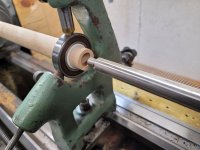This has been a good thread with lots of thoughtful insights from all the contributors - thanks for that. One aspect that hasn't been touched on is the repeatability/accuracy of scroll chucks. RidgeRaider has one on his headstock and one in the steady rest. Scroll chucks do not have great repeatability. Simply opening and closing the chuck on the bar can result in a .002"-.003" discrepancy. This difference can be rectified by tapping (not smashing) the jaw on the high side with a small brass or wood hammer. Using this technique, you can achieve a more consistent result when chucking your work. RidgeRaider, maybe you knew this and already incorporated it into your routine, but I hadn't seen it mentioned by anyone.
My 2 cents,
Gary
My 2 cents,
Gary
